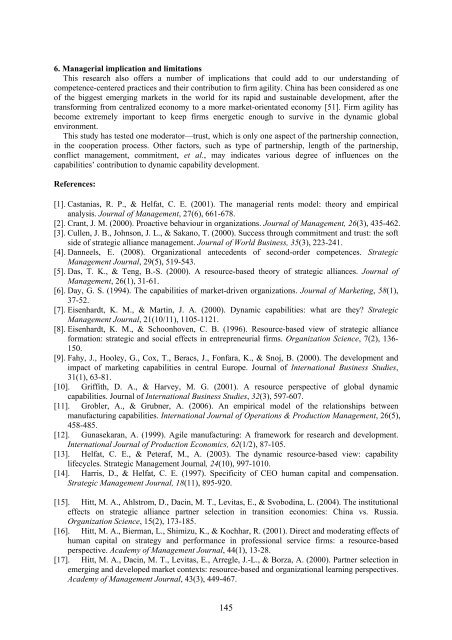Workshop proceeding - final.pdf - Faculty of Information and ...
Workshop proceeding - final.pdf - Faculty of Information and ...
Workshop proceeding - final.pdf - Faculty of Information and ...
Create successful ePaper yourself
Turn your PDF publications into a flip-book with our unique Google optimized e-Paper software.
6. Managerial implication <strong>and</strong> limitations<br />
This research also <strong>of</strong>fers a number <strong>of</strong> implications that could add to our underst<strong>and</strong>ing <strong>of</strong><br />
competence-centered practices <strong>and</strong> their contribution to firm agility. China has been considered as one<br />
<strong>of</strong> the biggest emerging markets in the world for its rapid <strong>and</strong> sustainable development, after the<br />
transforming from centralized economy to a more market-orientated economy [51]. Firm agility has<br />
become extremely important to keep firms energetic enough to survive in the dynamic global<br />
environment.<br />
This study has tested one moderator—trust, which is only one aspect <strong>of</strong> the partnership connection,<br />
in the cooperation process. Other factors, such as type <strong>of</strong> partnership, length <strong>of</strong> the partnership,<br />
conflict management, commitment, et al., may indicates various degree <strong>of</strong> influences on the<br />
capabilities’ contribution to dynamic capability development.<br />
References:<br />
[1]. Castanias, R. P., & Helfat, C. E. (2001). The managerial rents model: theory <strong>and</strong> empirical<br />
analysis. Journal <strong>of</strong> Management, 27(6), 661-678.<br />
[2]. Crant, J. M. (2000). Proactive behaviour in organizations. Journal <strong>of</strong> Management, 26(3), 435-462.<br />
[3]. Cullen, J. B., Johnson, J. L., & Sakano, T. (2000). Success through commitment <strong>and</strong> trust: the s<strong>of</strong>t<br />
side <strong>of</strong> strategic alliance management. Journal <strong>of</strong> World Business, 35(3), 223-241.<br />
[4]. Danneels, E. (2008). Organizational antecedents <strong>of</strong> second-order competences. Strategic<br />
Management Journal, 29(5), 519-543.<br />
[5]. Das, T. K., & Teng, B.-S. (2000). A resource-based theory <strong>of</strong> strategic alliances. Journal <strong>of</strong><br />
Management, 26(1), 31-61.<br />
[6]. Day, G. S. (1994). The capabilities <strong>of</strong> market-driven organizations. Journal <strong>of</strong> Marketing, 58(1),<br />
37-52.<br />
[7]. Eisenhardt, K. M., & Martin, J. A. (2000). Dynamic capabilities: what are they? Strategic<br />
Management Journal, 21(10/11), 1105-1121.<br />
[8]. Eisenhardt, K. M., & Schoonhoven, C. B. (1996). Resource-based view <strong>of</strong> strategic alliance<br />
formation: strategic <strong>and</strong> social effects in entrepreneurial firms. Organization Science, 7(2), 136-<br />
150.<br />
[9]. Fahy, J., Hooley, G., Cox, T., Beracs, J., Fonfara, K., & Snoj, B. (2000). The development <strong>and</strong><br />
impact <strong>of</strong> marketing capabilities in central Europe. Journal <strong>of</strong> International Business Studies,<br />
31(1), 63-81.<br />
[10]. Griffith, D. A., & Harvey, M. G. (2001). A resource perspective <strong>of</strong> global dynamic<br />
capabilities. Journal <strong>of</strong> International Business Studies, 32(3), 597-607.<br />
[11]. Grobler, A., & Grubner, A. (2006). An empirical model <strong>of</strong> the relationships between<br />
manufacturing capabilities. International Journal <strong>of</strong> Operations & Production Management, 26(5),<br />
458-485.<br />
[12]. Gunasekaran, A. (1999). Agile manufacturing: A framework for research <strong>and</strong> development.<br />
International Journal <strong>of</strong> Production Economics, 62(1/2), 87-105.<br />
[13]. Helfat, C. E., & Peteraf, M., A. (2003). The dynamic resource-based view: capability<br />
lifecycles. Strategic Management Journal, 24(10), 997-1010.<br />
[14]. Harris, D., & Helfat, C. E. (1997). Specificity <strong>of</strong> CEO human capital <strong>and</strong> compensation.<br />
Strategic Management Journal, 18(11), 895-920.<br />
[15]. Hitt, M. A., Ahlstrom, D., Dacin, M. T., Levitas, E., & Svobodina, L. (2004). The institutional<br />
effects on strategic alliance partner selection in transition economies: China vs. Russia.<br />
Organization Science, 15(2), 173-185.<br />
[16]. Hitt, M. A., Bierman, L., Shimizu, K., & Kochhar, R. (2001). Direct <strong>and</strong> moderating effects <strong>of</strong><br />
human capital on strategy <strong>and</strong> performance in pr<strong>of</strong>essional service firms: a resource-based<br />
perspective. Academy <strong>of</strong> Management Journal, 44(1), 13-28.<br />
[17]. Hitt, M. A., Dacin, M. T., Levitas, E., Arregle, J.-L., & Borza, A. (2000). Partner selection in<br />
emerging <strong>and</strong> developed market contexts: resource-based <strong>and</strong> organizational learning perspectives.<br />
Academy <strong>of</strong> Management Journal, 43(3), 449-467.<br />
145
















